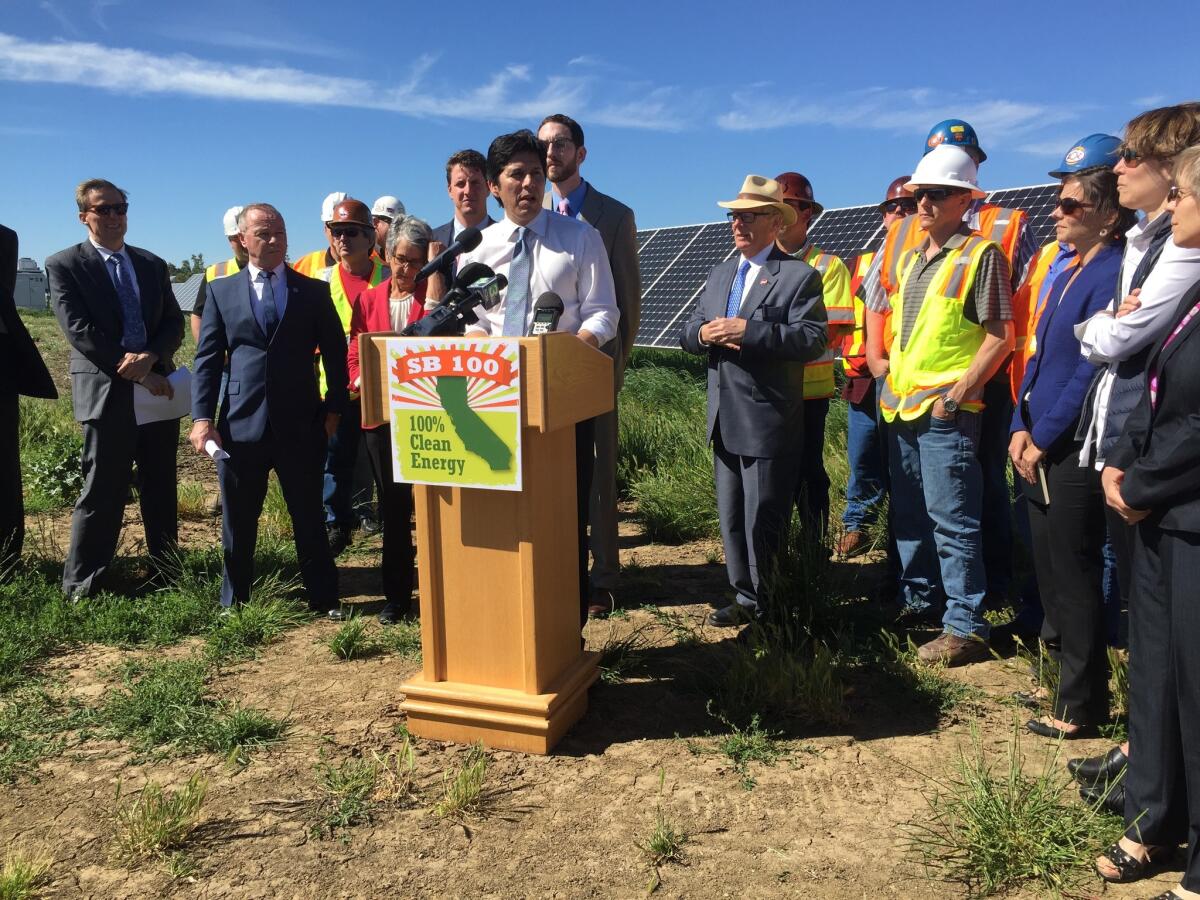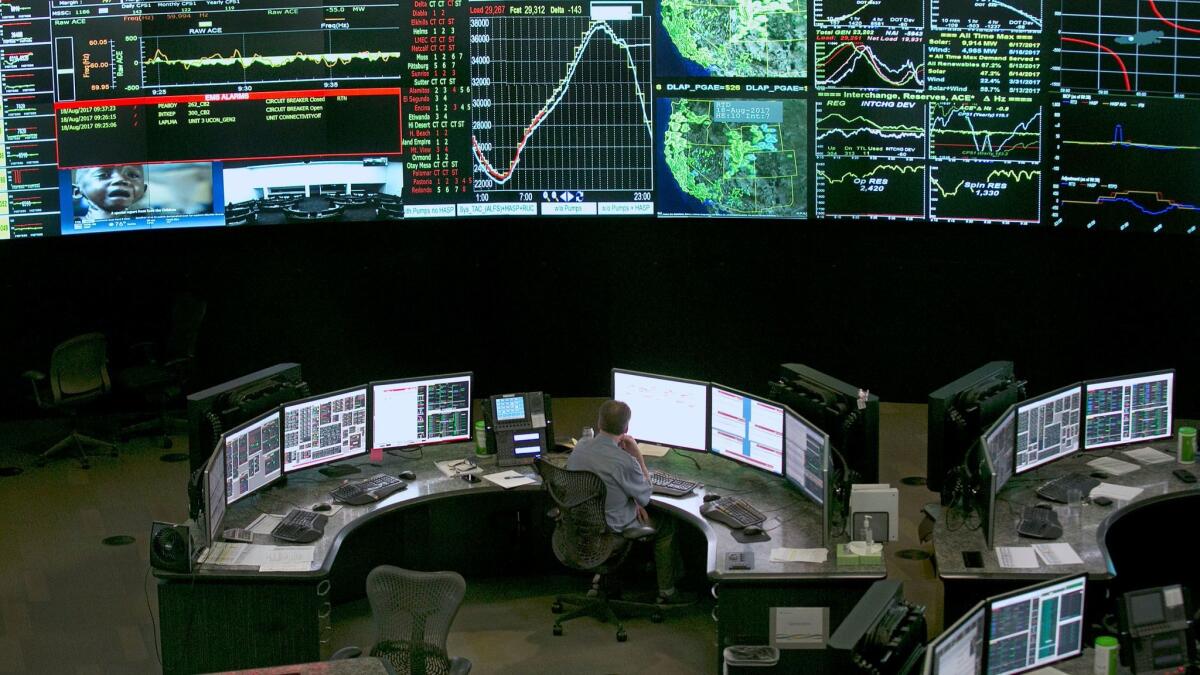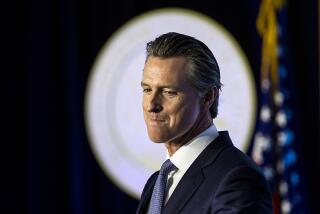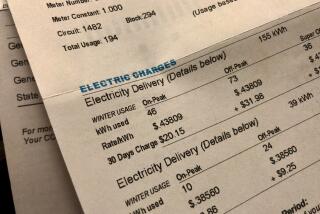California’s goal: an electricity grid moving only clean energy
Reporting from Sacramento — California lawmakers are considering a future without the use of fossil fuels to generate electricity, a step that would boost the renewable energy industry and expand the scope of the state’s battle against global warming.
If approved at the end of the legislative session next month, the proposal would eventually ensure only clean energy moves through the state’s electricity grid, a goal nearly unmatched anywhere in the world.
It would accelerate the adoption of renewable energy by requiring utilities and other electricity providers to obtain 60% of their power from resources such as the sun and wind by 2030. Then it would task regulators with phasing out fossil fuels for the remaining 40% by 2045.
The goal: Less than three decades from now, no coal or natural gas would be burned when Californians charge their electric cars, run their air conditioners or flip on their lights.
The lofty ambition of the legislation, Senate Bill 100, could come with similarly steep challenges.
New solar plants and wind turbines would need to be built in addition to massive batteries connected to the grid to store energy for when the sun isn’t shining or the wind isn’t blowing.
The state would no longer be able to rely on natural gas — which can be turned on and off to match demand — to help balance a complex electricity grid that stretches across deserts, snow-capped mountain ranges, urban sprawl and rural farmland.
“It’s doable,” said Mike O’Boyle, who studies the power sector at Energy Innovation, a think tank in San Francisco. “But because we don’t really have a working example for a 100% renewable system, it’s going to be an ongoing experiment.”
Hawaii became the first state to set such a target two years ago, but California would be trying to achieve the goal at a much larger scale. Germany and France, countries with economies closer in size to California’s, are also working to phase out fossil fuels for electricity.
Compared with the political firestorm over extending the state’s cap-and-trade program earlier this year, the electricity proposal has flown under the radar. It was passed by the state Senate in May and requires approval from the Assembly before it can be sent to Gov. Jerry Brown’s desk.
Senate President Pro Tem Kevin de León (D-Los Angeles), who authored the legislation, said he’s confident the state can pull it off. He compared the speed of renewable energy innovation to the rapid spread of the Internet.
“That’s the type of opportunity we have today, right here in California, with clean energy,” he said.
But utilities and some business groups have concerns.
“We want to help California achieve its bold clean energy goals in a way that is affordable for our customers,” said Lynsey Paulo, a spokeswoman for Pacific Gas & Electric Co., the state’s largest utility. “If it’s not affordable, it’s not sustainable.”
An estimate from nonpartisan legislative analysts shows renewable energy regulations are a relatively costly way to reduce greenhouse gas emissions.
“It’s a more expensive, less flexible approach to reducing emissions,” said Loren Kaye, president of the California Foundation for Commerce and Education, a think tank affiliated with the California Chamber of Commerce.
He said ratepayers will end up covering the cost in their utility bills.

California has been marching toward higher levels of clean energy for years, and state officials said the transformation is happening even faster than expected. The state generated 29% of its power from solar, wind, geothermal and other renewable sources in 2016.
A law authored by De León and signed by Brown in 2015 already requires California to obtain 50% of its electricity from renewable sources by 2030.
SB 100 would increase that target to 60%, then require the final 40% to come from “zero-carbon” sources that don’t produce greenhouse gases by 2045. That could include more solar and wind power, but also large hydroelectric dams that haven’t previously been counted as renewable sources under state law.
There would be no coal and, most notably, no natural gas, which provided more than a third of California’s electricity last year, according to state statistics.
Not only has natural gas been the largest source of power, it’s been a critical tool for managing ebbs and flows in renewable energy. For example, when the sun goes down in the evening, natural gas plants increase their output to ensure there’s enough electricity on the grid to keep the lights on as residents return home from work.
“Clean natural gas power will continue to play an important role in providing reliable, affordable electricity for some time,” said Kassandra Gough, external affairs director at Houston-based Calpine, which operates 20 natural gas plants in the state.

Boosting the amount of renewable energy would require new strategies to balance the electricity grid.
V. John White, director of the Center for Energy Efficiency and Renewable Technologies, said the state can help by improving cooperation among various agencies. Right now the California Public Utilities Commission, the California Energy Commission and the California Independent System Operator all share responsibility for the state’s electricity agenda, and White said there should be a more holistic approach.
“There needs to be institutional reform,” he said.
California is also using a series of regulations and state-funded incentives to get millions more zero-emission vehicles on the road in the coming decades. If officials are successful, an electrified network of cars could help balance the grid by charging when the sun is shining the brightest or the winds are blowing the strongest.
“Electric vehicles are the peanut butter to renewable energy’s jelly,” said Tom Buttgenbach, president of 8minutenergy, which develops solar power plants.
Follow live coverage from the Capitol on Essential Politics »
There’s also a push to integrate California’s electricity grid with neighboring states. Supporters believe the idea would save ratepayers money and help spread clean energy. For example, Californians could potentially rely on wind power from Wyoming during a cloudy day over solar plants in the Central Valley.
“It’s one of the tools we absolutely must have,” said Ralph Cavanagh , a lawyer at the Natural Resources Defense Council.
Opponents include some unions, who fear construction and utility jobs will leave California. Other skeptics worry about sacrificing control of the electricity grid by cooperating with states that may not be as committed to fighting global warming.
“Who are our first dance partners in this?” said Evan Gillespie, the Sierra Club’s western region deputy director. “How are we aligning ourselves with other states with shared interests?”
Brown’s push for a regional grid stalled last year. Negotiations are ongoing, but it’s unclear if progress will be made before the end of the legislative session on Sept. 15.
Times staff writer Mina Corpuz contributed to this report.
Twitter: @chrismegerian
ALSO
California set an ambitious goal for fighting global warming. Now comes the hard part
Updates on California politics
More to Read
Get the L.A. Times Politics newsletter
Deeply reported insights into legislation, politics and policy from Sacramento, Washington and beyond. In your inbox three times per week.
You may occasionally receive promotional content from the Los Angeles Times.











